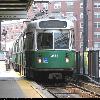

Tags: Massachusetts Bay Transportation Authority View |
Tags: Massachusetts Bay Transportation Authority View |
The Massachusetts Bay Transportation Authority, often referred to as the MBTA or simply The T, is "a body politic and corporate, and a political subdivision" of the Commonwealth of Massachusetts formed in 1964 to finance and operate most bus, subway (Rapid transit), commuter rail and ferry systems in the greater Boston (Boston, Massachusetts), Massachusetts, area. It replaced the Metropolitan Transit Authority (MTA), immortalized by the Kingston Trio in the popular folk-protest lament "M.T.A." Locals call it simply "The T", after its logo, the letter T in a circle, adopted in the 1960s inspired by the Stockholm Metro. In 2008, the system averaged 1.3 million passenger trips each weekday, of which the subway averaged 598,200, making it the fourth busiest subway system (List of United States rapid transit systems by ridership) in the United States.Ridership rising fast, MBTA announces Boston Globe June 6, 2008. The Green Line (Green Line (MBTA)) and Ashmont-Mattapan High Speed Line of the T comprise the busiest light-rail system in the U.S (List of United States Light Rail systems by ridership), with a weekday ridership of 255,100.
The MBTA also operates an independent law enforcement agency, the Massachusetts Bay Transportation Authority Police. In 2006, 31.60% of workers in the city proper (City limits) commuted by public transport.
The MBTA is one of only two U.S. transit agencies that operate all of the five major types of transit vehicles: regional (commuter) rail trains, "heavy" rapid transit (subway/elevated) trains, light rail vehicles (trolleys), electric trolleybuses and motor buses. The other is Philadelphias Southeastern Pennsylvania Transportation Authority (SEPTA) (SEPTA).
The MBTA is the largest consumer of electricity in Massachusetts, and the second-largest land owner after the Department of Conservation and Recreation (Department of Conservation and Recreation (Massachusetts)). As of 2007, its CNG bus fleet was the largest consumer of alternative fuels in the state.
On June 26, 2009, Governor Deval Patrick signed a law to place the MBTA along with other state transportation agencies within the administrative authority of the Massachusetts Department of Transportation (MassDOT), with the MBTA now part of the Mass Transit division (MassTrans). The 2009 transportation law continued the MBTA corporate structure and changed the MBTA board membership to the five Governor-appointed members of the Mass DOT Board.
Image2: MBTA services sampling excluding MBTA Boat.jpg
Locale: Greater Boston
Transit Type: Commuter rail (Commuter rail in North America), rapid transit, light rail, bus, BRT (Bus rapid transit), trolleybus, ferryboat
Chief Executive: Richard A. Davey
Headquarters: Massachusetts State Transportation Building,10 Park Plaza, Boston, MA (Boston, Massachusetts) 02116
Began Operation: 1897 (light rail),1901 (rapid transit),1964 (MBTA)
System Length: mi to km1193precision=0abbr=yes (total),mi to km38precision=0abbr=yes (rapid transit),mi to km26precision=0abbr=yes (light rail),mi to km8precision=0abbr=yes (BRT),mi to km751precision=0abbr=yes (bus and trackless trolley),mi to km368precision=0abbr=yes (commuter rail)
Track Gauge: RailGaugeussg
Lines: 12 (commuter rail),4 (rapid transit),5 (light rail),4 (trolleybus),4 (ferryboat),183 (bus)
Stations: 123 (commuter rail),51 (rapid transit),74 (light rail),22 (BRT)
Ridership: 1.3 million (weekday, all modes)
Operator: MBTA (most bus, subway, BRT, trolleybus, light rail),----,MBCR (commuter rail),----,Harbor Express/Boston Harbor Cruises (Boat),----,various contractors (700-series bus routes)


